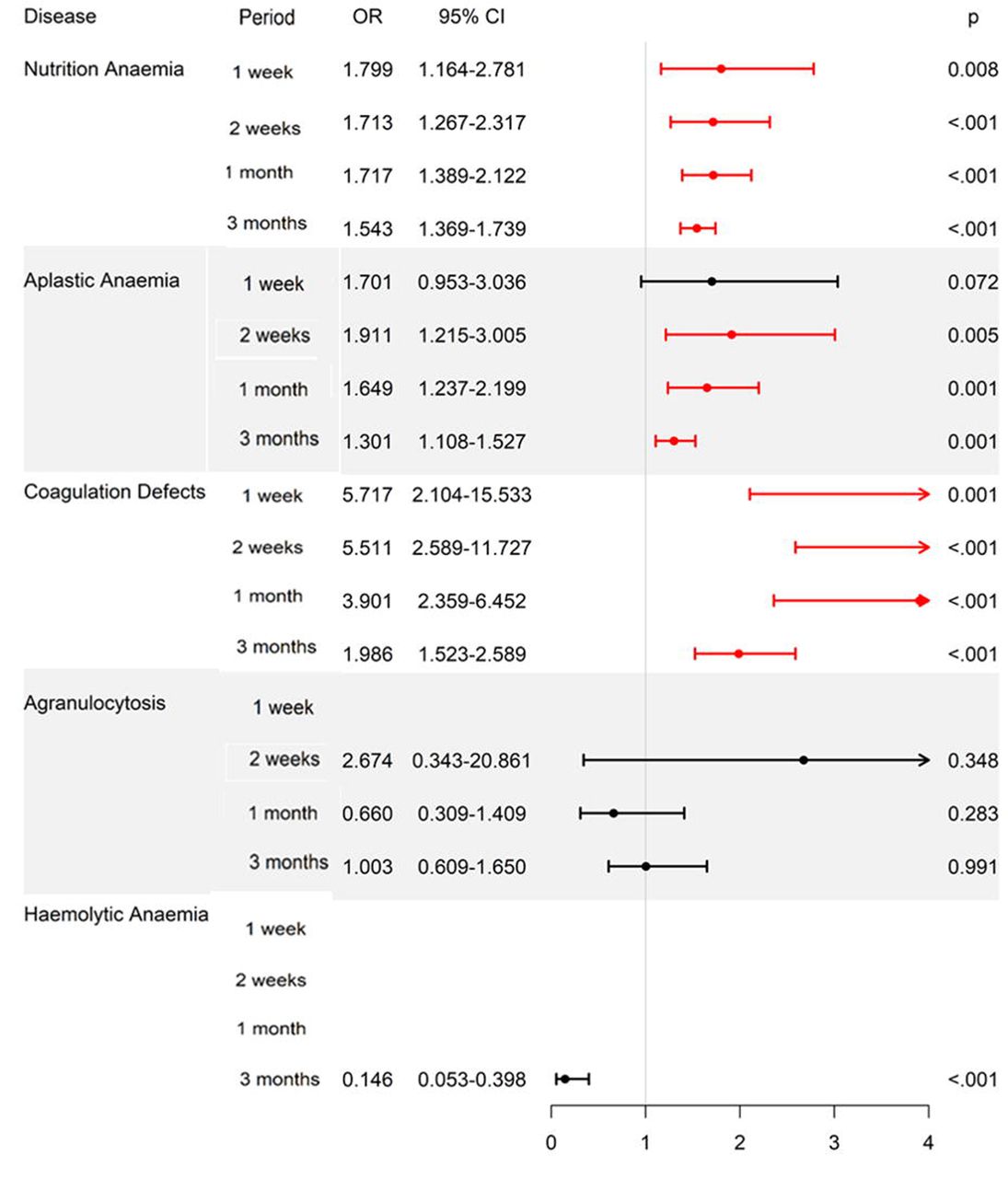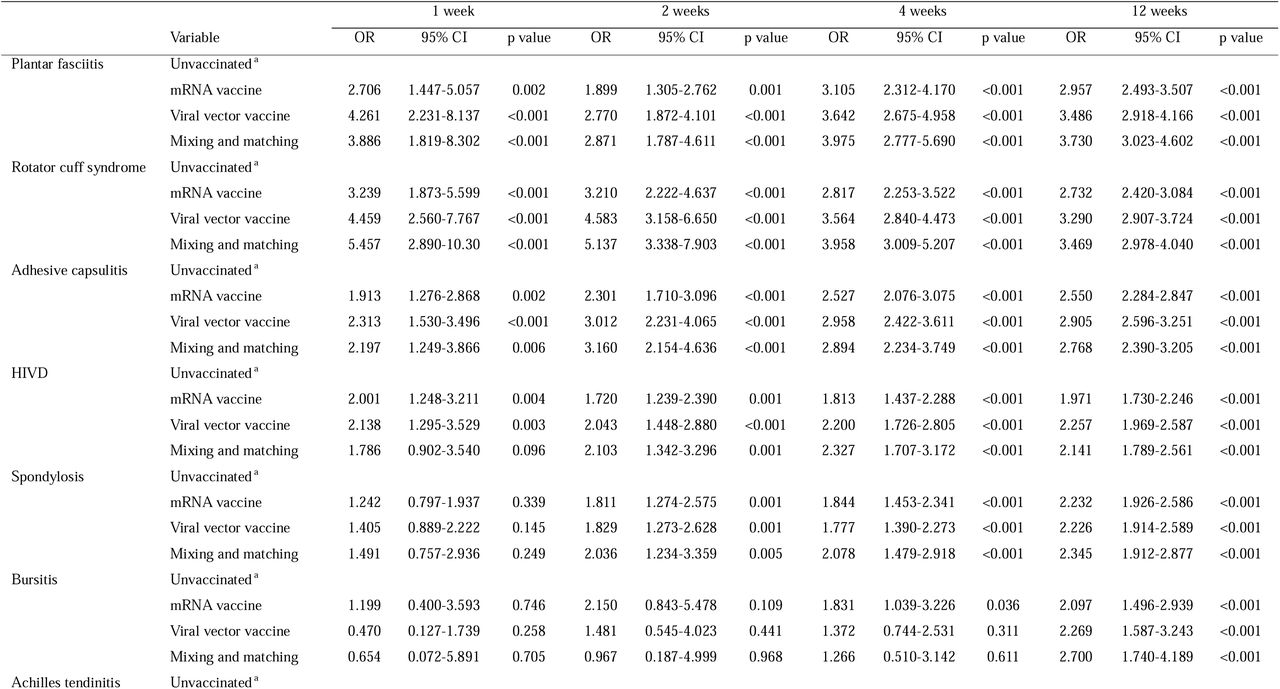1 - "The spectrum of non-fatal immune-related adverse events following COVID-19 vaccination: The population-based cohort study in Seoul, South Korea". (2023).
2 - "Hematologic abnormalities after COVID-19 vaccination: A large Korean population-based cohort study". (2023).
3 - "Correlation between COVID-19 vaccination and inflammatory musculoskeletal disorders". (2023).
Review Date: December - 2023
We review 3 population-based studies from South Korea that show a relationship between the Covid-19 vaccinations and subsequent diverse non-fatal adverse events. The main author for the three papers is Eun Mi Chun, who, with access to the population dataset analysed incidence rates of different non-fatal health conditions from the date of the Covid-19 innoculation. The authors compare the incidence rates for the different conditions in vaccinanted versus un-vaccinated individuals, up to 12 weeks prior the innoculation date. The results were published in three different papers as they investigated different types of adverse events.
Paper 1, provides a population-based analysis of immune-related adverse events associated with the Covid-19 vaccinations in South Korea. The paper reference is:
Eun Mi Chun et. al., "The spectrum of non-fatal immune-related adverse events following COVID-19 vaccination: The population-based cohort study in Seoul, South Korea". (2023). Link to paper.
Paper 2, investigates haematologic abnortmalities following Covid-19 vaccinations on a population-based cohort. The paper reference is:
Eun Mi Chun et. al., "Hematologic abnormalities after COVID-19 vaccination: A large Korean population-based cohort study". (2023). Link: Link to paper
Paper 3, investigates the relationship between inflammatory musculoskeletal disorders and the Covid-19 vaccinations. The paper reference is:
Eun Mi Chun et. al., "Correlation between COVID-19 vaccination and inflammatory musculoskeletal disorders". (2023). Link to paper.
Comments:
These research papers are of particular relevance as they investigate non-fatal adverse events related to the Covid-19 vaccinations. Until now, most of the litearture and concerns amongst scientists who are investigating post- Covid-19 vaccinations effects are focused mainly serious AEs such as cardiovascular, malignant neoplasms and neurological problems that can give rise to fatal conditions. However, the impact on individuals' health from adverse effects from the Covid-19 vaccinations are not limited to death, but also manifest as disabilities and milder injuries.
These research papers corroborate our research on the increase in disabilities (for the UK and US) as well as the increase in absence rates which were relate to injuries due to the Covid-19 vaccinations.
Additionally, these three papers show, at a populations level, strong evidence for increased incidence rates of non-fatal medical conditions following the covid-19 vaccinations. The types of injuries descbribed in these paper are corroborated for our research on the rise in new disability claims to the PIP system in the UK, where we investigate trends in PIP claims by underlying cause.
Note:
When summaring each paper we use quotes taken directly from each of the papers. When doing so we " format the text in italic and in between double quotes ".
Methods (Data source):
"
This from the Korean National Health Insurance Service (NHIS) database on 1, January 2021 enrolled randomly extracted 50% of individuals residing in Seoul, South Korea. We randomly selected 50% of the residents living in Seoul as of January 1, 2021, and obtained their diagnostic records from 2020 to 2021. The International Classification of Diseases, 10th revision (ICD-10), was adopted by the NHIS to classify disease diagnoses. The data included the primary diagnosis, secondary diagnosis, and dates of hospital visits. This population-based cohort study was conducted by the Strengthening the Reporting of Observational Studies in Epidemiology (STROBE) guidelines.
"
Results:
The table below was constructed by us, with the results taken from table 2 of the paper. It summarises the main results of the analysis.

Notes:
The results show statistically significant higher incidence rates for individuals post-vaccination compared to unvaccinated Individuals. As an example, after 3 months menstrual disorder rates were 25.5% higher in vaccinated women than non-vaccinated women; Inner ear disease rates were 193% higher in vaccinated individuals compared to unvaccinated ones, after 3 months. The results show similar results for all the investigated health conditions.
The results shown in this paper corroborate our analysis of increases in disabilities by cause of underlying claim, which we performed for the UK PIP system.
Methods (Study Design and Population):
Data source: " Korea has implemented a unique national public health insurance system for all its citizens called the Korean National Health Insurance Service (KNHIS). The KNHIS database includes data on all medical treatments and disease codes of the International Classification of Disease, 10th revision (ICD-10). We randomly selected data of half of those living in Seoul City as of January 1, 2021, from the KNHIS database and obtained their 2020-2021 diagnostic records. The diagnosis records included the main and secondary diagnoses, and date hospital visit. Of a total 4,348,412 individuals selected, those 4,203,887 aged >20 years were included.
"
Study Design:
"
Those who received the first vaccination only, died, or had hematologic disease as the primary or secondary diagnosis were excluded from the study. The date of participation in the cohort (index date), was set differently for vaccinated (date of completion of a second
vaccination by September 30th, 2021) and non-vaccinated individuals (set as September 30, 2021). Diagnosis records for 365 days prior to the index date were tracked.
"
Results:
The table below, copied from figure 1 of the paper, summarises the main results of the analysis.

Figure 1. Odd ratio for hematologic abnormalities after vaccination according to the period.
Notes:
The paper shows statistically significant higher incidence rates for haematologic effects post-vaccination when compared to unvaccinated Individuals. The results indicate that the haematologic abnormalities tend to be stronger 1 week after the shots and decline over time, up to the 3 month mark. For example, Aplastic anaemia was 70.1% higher 1 week while only 30.1% higher after 3 months. Coagulation deffects were 472% higher 1 week after the shot while only 98.6% higher 3 months after the shots. The results are highly statistically significant.
The results shown in this paper corroborate our analysis of increases in disabilities by cause of underlying claim, which we performed for the UK PIP system.
Methods (Study Design and Population):
" This nationwide, population-based, retrospective cohort study used data from the Korean NHIS.10 98 On January 1, 2021, 50% of the residents of Seoul were randomly selected and included in the study population. The incidence of musculoskeletal disorders among the participants was then analyzed according to their vaccination status. Individuals who received two doses of the COVID-19 vaccine were defined as vaccinated, and their index date was the date of their second vaccination, prior to September 30, 2021. In contrast, the index date for unvaccinated individuals was September 30, 2021. Those who received only one dose of the vaccine and those who started vaccination after September 30, 2021, were excluded from the study. Diagnostic records for 365 days prior to the index date were reviewed, and individuals with any target musculoskeletal disorders as a primary or secondary diagnosis were excluded. If the target musculoskeletal disorder was the primary diagnosis on the day after the index date, it was defined as an event (Figure 1). "
Results:
The table below, copied from the table 3 of the paper, summarises the main results of the analysis


Table-3. Results of multivariate logistic regression model to assess the risk of musculoskeletal disorders after COVID-19 vaccination.
Limitations:
"
Our study also has several limitations. First, because the target musculoskeletal disorders were identified by ICD-10 codes in the claims database, coding, mismatching, or misclassification errors could have occurred. Discrepancies might have occurred between the actual disease and the diagnosis claimed by the healthcare provider, and over- or underdiagnosis may occur. Second, our study could not confirm the pathophysiological mechanism of the change in the incidence of musculoskeletal disorders after COVID-19 vaccination because it relied only on diagnoses claimed by healthcare providers. As COVID-19 vaccines are frequently accompanied by arthralgia and myalgia, whether these adverse reactions were disdiagnosed as inflammation-mediated musculoskeletal disorders or whether the pain was caused by an actual inflammatory disorder is unknown.
"
Strength's:
"
The strength of our study is underscored by its substantial sample size, which comprises data from over 2 million individuals randomly selected from the Korean NHIS. This comprehensive database, which encompasses medical services for 97% of the population, enhances the reliability and representativeness of our findings. Such large population-based databases, which are available only in Taiwan, Sweden, and Korea, are excellent resources for answering questions that are difficult to address using single-institution or small-scale studies.
"
Notes:
The results show statistically significant higher incidence rates for muscoloskeletal disorders post-vaccination compared to unvaccinated Individuals. The muscoloskeletal disorders appear to be persistent over time with similar odds ratio after 1 week to 12 weeks after the innoculations. As an example, for mRNA vaccine recipients, adhesive capsulitis disorders, incidence rates were 91.3% higher 1 week after vaccination and 155% higher 12 weeks after vaccination. Viral vector vaccines show a similar pattern.
The results shown in this paper corroborate our analysis of increases in disabilities by cause of underlying claim, which we performed for the UK PIP system.
In this section we provide some observations and thoughts related to the papers that are reviewed above. These observations are of revelance in the context of many of our ongoing research projects that investigate excess deaths and disabilities during the pandemic years. These papers investigate non-fatal adverse events following the Covid-19 vaccines, which corroborate our research on rises in disabilities from 2021 as the Covid-19 innoculations were rolled out. In particular these papers are directly related to and corroborate our research of trends in disabilities by cause of underlying claim in the UK PIP system.
Even though the increases in incidence rates of immune-related adverse effects, muscoloskeletal disorders and haematologic abnormalities described in the papers do not necessarily directly imply that these conditions are severe enough to translate into disabilities, our research on the PIP system provides evidence that indeed some do. The relative increase in disability claims, for different causes, that we observe in the PIP system are inline with the respective increases in incidence rates described in the papers.
Go to UK analysis of PIP (disability) claims by underlying cause
